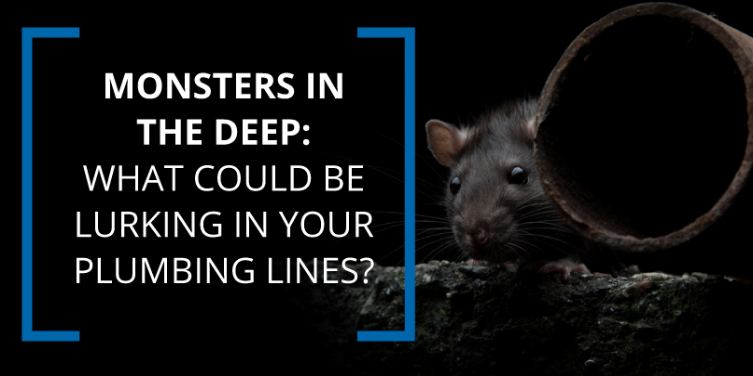
If you have ever dealt with an infestation of mice, insects or other household pests, you know how tricky it can be to get rid of them, not to mention the damage they can cause. While many people expect to see a mouse scurrying around in the kitchen or a cockroach running for cover in the basement, they might not think of those creatures as the cause of plumbing issues.
Sure enough, there are critters who can get into your home through the pipes and plumbing. At best, they are a nuisance. At worst, they can cause expensive damage.
While the damage created by mice and other animal pests is usually pretty evident, some living organisms can produce less visible, but even more dangerous, issues in your home's pipes. Some pipes are the ideal spot for harmful bacteria to grow and thrive.
Whether they are four-legged, six-legged or microscopic, you don't have to live with critters and creatures invading your plumbing.
Critters That Can End Up in Your Plumbing
Many animals make their way into your home through the plumbing because they are looking for a drink or someplace warm to sleep, preferably with an ample supply of food. Here are six examples of some of the critters that can get into your plumbing, and how you can learn to recognize the signs you have an unwanted house guest.
1. Mice and Rats
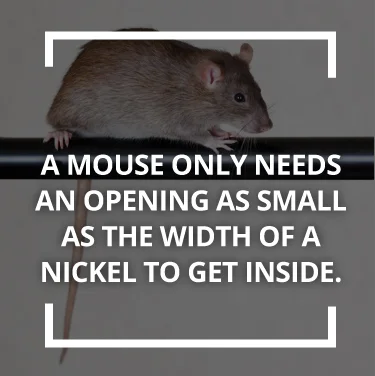 It doesn't take much for a mouse to squeeze its way into your home. An opening as small as the size of a nickel is all they usually need to get inside. Rats need a slightly larger opening — about the size of a half dollar — to get in. If there are any gaps around the pipes under your sinks, washing machine or other plumbing, they might be small enough for a mouse to make its way into your home. Mice can also get inside through any unsealed drainage pipes.
It doesn't take much for a mouse to squeeze its way into your home. An opening as small as the size of a nickel is all they usually need to get inside. Rats need a slightly larger opening — about the size of a half dollar — to get in. If there are any gaps around the pipes under your sinks, washing machine or other plumbing, they might be small enough for a mouse to make its way into your home. Mice can also get inside through any unsealed drainage pipes.
The methods a rat uses to get into your home through the plumbing can be a bit more alarming. While mice might squeeze between spaces around the pipes, some types of rats aren't afraid to swim through the pipes, meaning they can get into your home through the sewer pipes and exit from your toilet. Rats can swim for up to three days, and they will eat pretty much anything that gets in their way. These rodents can not only thrive in sewer pipes, but they can also enter your home through them.
Signs of Mice or Rats in Your Plumbing
How can you tell if you have mice or rats in or around your plumbing? In the case of rats in the plumbing, you might have a pretty frightening experience — like walking into your bathroom and seeing a rat climb out of your toilet. Mice are a bit more discrete. You're not likely to spot one unless the infestation is severe. Instead, you'll want to keep an eye out for signs of a mouse, such as droppings under the sink or behind your bathtub or toilet.
You might also see evidence of mice trying to make nests, such as piles of ripped-up paper, tiny pieces of fabric, or shredded plant materials. If the mice are in your kitchen, the first place they’re heading to is the food supply in your pantry. Mice can chew through plastic packaging, so you might suddenly find holes in your chip bags or piles of crumbs spilling out onto the shelves and floors.
2. Frogs
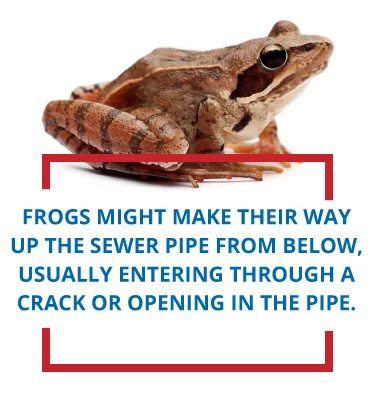 Frogs, as you might know, are amphibious creatures. That means that they are adapted to living both on land and in the water. Many frogs start their lives living in water, then make their way to land as adults. But, they need to remain close to a source of water so their skin does not dry out.
Frogs, as you might know, are amphibious creatures. That means that they are adapted to living both on land and in the water. Many frogs start their lives living in water, then make their way to land as adults. But, they need to remain close to a source of water so their skin does not dry out.
That's where your home's plumbing comes in. The opening of a water pipe may seem like it would provide the moist environment a frog needs, but many find themselves in over their head.
Where a frog comes into your home's plumbing depends in large part on the type of frog. Tree frogs can climb up to the roof of your house and get in through the chimney or a vent pipe, making their way down to your toilet. Other types of frog might make their way up the sewer pipe from below, usually entering through a crack or opening in the pipe.
3. Lizards and Salamanders
Lizards might not be a common sight in Oneida, but there are salamanders in the area. Salamanders look like lizards, but are amphibians, like frogs. There are also pet lizards that can get loose in the neighborhood.
If someone's pet lizard gets loose, it could make its way up your sewer pipes and into your toilet — naturally, cold-blooded lizards tend to seek out areas that are warm. Lizards also tend to be pretty good swimmers, so navigating up a drain or sewer pipe is not much of a challenge.
You'll be able to tell you have a lizard or salamander in your plumbing if you open up the lid of your toilet one day and see a critter splashing around.
4. Snakes
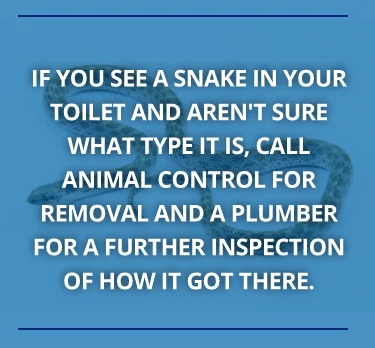 For many people, having a snake slither up a pipe and into a toilet bowl might be a scene out of their worst nightmare. Not only is the scenario possible, but it happens more often than you may think. There have been stories from across the U.S. and around the world concerning snakes in toilets. Usually, you hear how they make their presence known in alarming ways.
For many people, having a snake slither up a pipe and into a toilet bowl might be a scene out of their worst nightmare. Not only is the scenario possible, but it happens more often than you may think. There have been stories from across the U.S. and around the world concerning snakes in toilets. Usually, you hear how they make their presence known in alarming ways.
The good news for homeowners in Oneida is that most of the snakes who call New York home aren't poisonous. The other good news is that it's very rare for a snake to make its way into your plumbing — but it can happen. If you see a snake in your toilet and aren't sure what type it is, call animal control for removal and a plumber for a further inspection of how it got there.
5. Possums
If you see a possum crawling out of your toilet, it's most likely a baby possum, as adults are usually too big. But, like rats, possums can swim for long distances and can hold their breath for longer than you may realize. Since possums can carry rabies and other diseases, don't touch the one splashing around your toilet bowl, no matter how cute it looks. Call in animal control, as well as a plumber, for help.
6. Insects
Bugs, both good ones and bad ones, might make their homes in and around your drains and pipes. It makes sense since your plumbing system often offers the things insects need: moisture and warmth. Depending on the type of bug you're dealing with, the insects could be coming up from the plumbing, or they could first be getting inside your home and then navigating toward the plumbing.
For example, drain flies are appropriately named because they lay their eggs in the slimy material that usually forms in drains. Once those eggs hatch, the tiny flies — which look like tiny, fuzzy moths — hang out around the drains, as the slime also provides food for them.

Cockroaches can also get into your home through the drains. Since they love water, once they're in your home, you're likely to find them hanging around any areas where water collects, such as the bottom of the sink or bathtubs.
In contrast, bugs like house centipedes might seem to come out of the drains in sinks or tubs, but they often end up there because they have fallen in and can't get out.
How Do Animals Get Into My Plumbing?
Critters can get into your plumbing in many ways. In some cases, they come up from below. In others, they fall from up above. It might also be the case that the animals seem to be coming in through the plumbing or pipes, but are in reality squeezing their way in through a small opening near the pipes.
Here are a few places where animals can make their way into your plumbing:
- The Stack Pipe: Your home has a stack pipe, or a vent pipe, that stretches from the bottom of the plumbing system beyond the roof of your house. On the roof, the stack pipe lets out any fumes that can collect in the sewer line, keeping your house from developing a terrible odor. In some cases, critters can get to the roof of your home by crawling up the gutters, or by falling from any trees that overhang your roof. Once they’re on the roof, your stack pipe might look warm and inviting to them, or they might just be exploring. If nothing is covering the pipe, it's possible for the critter to climb down it toward your toilets.
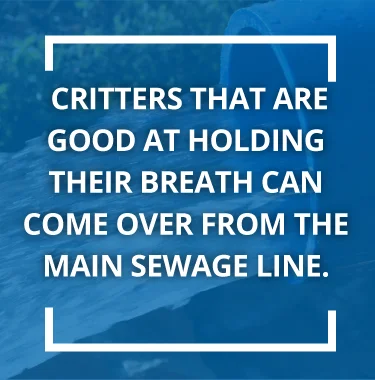 The Sewer Line: While some creatures get into the plumbing by climbing down, others get there by climbing up. Critters that are good at holding their breath can come over from the main sewage line in your town to your home's waste pipes. From there, they can work their way up to the toilet. Since there's not much water in the pipes that connect your toilet to the main waste line, these critters don't need to worry about holding their breath.
The Sewer Line: While some creatures get into the plumbing by climbing down, others get there by climbing up. Critters that are good at holding their breath can come over from the main sewage line in your town to your home's waste pipes. From there, they can work their way up to the toilet. Since there's not much water in the pipes that connect your toilet to the main waste line, these critters don't need to worry about holding their breath.
- Openings Near Pipes and Drains: Not every creature is looking to slither up a pipe or climb in through a drain. For some, the small openings between a pipe and a wall can provide the perfect entryway into your home.
How to Keep Animals and Bugs Out of Your Plumbing
The animals and insects that decide to set up camp in or around your drains and plumbing have learned your home is warm and comfortable, not to mention a wonderful place for finding food and water. The best way to keep those creatures out is to physically block them. If they're already in, making your home as inhospitable for them as possible can help. Here are six strategies to try.
1. Cover Up Pipe Openings
Often, the first line of defense when it comes to keeping animals out of your plumbing system is to figure out where they are getting in, then block off those entrances. If you have had a few visitors who have seemed to come from your roof, such as tree frogs or possums, it is very likely an open stack pipe is to blame.
You can purchase a stack pipe cap to put over the top of the pipe. The cap contains openings that let the gas and fumes out, but are small enough that critters can't get in. Another option is to make a DIY cover for the pipe by wrapping chicken mesh or wire over the pipe, then securing it with a zip-tie or other attachment.
 In the case of critters who enter your plumbing through the waste pipes, installing a multi-flap in your toilets should keep them out of the toilet bowl.
In the case of critters who enter your plumbing through the waste pipes, installing a multi-flap in your toilets should keep them out of the toilet bowl.
2. Seal Up Cracks and Openings
Remember, mice don't need much space at all to get in through a break or opening. If you see evidence of mice around your house, or if you see an actual mouse, take a closer look at the pipes that lead to your kitchen or bathroom. A small crack can be enough for a mouse to squeeze in and make itself right at home.
You can seal up or block off openings in a few ways. One option is to stuff steel wool into cracks. You can also fill openings with caulk to keep the mice out.
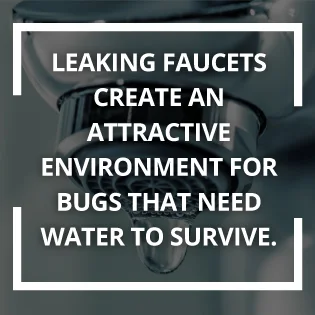 3. Fix Leaking Faucets
3. Fix Leaking Faucets
Leaking faucets create an attractive environment for bugs that need water to survive. If you notice roaches hanging around your sinks, even if you do your best to keep the sink surface dry, check if the faucets are leaking. A steady drip of water is enough to keep roaches well-hydrated.
4. Trim Trees and Shrubs Around Your Home
Tree branches that hang over your roof aren't only a problem when there's a storm — they can also provide tree frogs, possums, and other pests with a direct line of access to your home, through the roof and the stack pipe. Keep tree branches well-trimmed to protect your house from storm damage and pests.
Trimming any shrubs around the perimeter and foundation of your home and clearing out any weeds or wild-growing plants will also help to protect your house from critters. All that plant debris can give mice, rats, and other pests a place to nest and hide. Once it's gone, the pests will skedaddle, too, since you have eliminated their hiding spots.
5. Clean the Drain
Keeping the drains in your sinks and bathtubs clean will help you avoid an infestation of drain flies. There are a few ways you can clean your drains, and some are better than others. Usually, it's smart to skip pouring any harsh cleaners or chemicals down the drains.

The harsh chemicals might clear away the slime that attracts drain flies, but they can also damage and corrode the pipes. Instead, wet the drains by running warm water down them, then give them a good scrubbing with a pipe brush. You might also want to shut off the water and remove the trap from the drain, then give it a good scrubbing, as well.
6. Remove any Food
This last bit of advice might be easier said than done, but it's best to keep any food sources out of the reach of any critters and bugs that get into your home. That means keeping pantry items in well-sealed, critter-proof containers. It also means washing up your dishes and surfaces, as well as thoroughly drying them, after you eat.
You don't have to go it alone when pest-proofing your home and plumbing system. If you are not sure how to install a multi-flap or how to fix a leaky faucet, a quick call to your plumber can help you out and help you say goodbye to pests.
Types of Bacteria That May Be Lurking in Your Plumbing
If an animal decides your toilet is the perfect place for a swim or a nap, you will spot it pretty quickly. Even if you don't see a pest, like a mouse, they usually leave enough evidence to make their presence known. But unfortunately, not every living organism is so easy to spot. Bacterial growth can be downright nasty and hazardous to your health, but difficult to detect. In some cases, an infestation can make you and others who use your home's plumbing very sick.
By this point, you probably know not all types of bacteria are the same. Some are friendly and good for you —called beneficial bacteria — and can be found in foods such as yogurt. But, some bacteria aren't helpful at all. In fact, they can cause significant illness and damage.
These dangerous bacteria might be lurking in your plumbing — here are three to look out for that can cause plumbing issues and even illness.
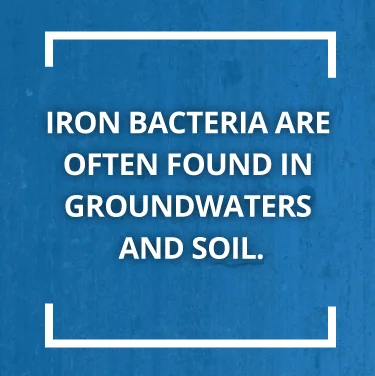 1. Iron Bacteria
1. Iron Bacteria
The good news about iron bacteria, aka Gallionella or iron-oxidizing bacteria, is that it usually doesn't cause any health issues. But, that doesn’t mean they’re completely harmless.
Iron bacteria are often found in groundwaters and soil. They can thrive in waters with higher levels of iron than average since the bacteria feed on dissolved iron particles. However, water doesn't have to have unusually high iron levels to have an infestation of iron bacteria.
The big issue with having iron bacteria in your pipes or well is that it builds up and can cause clogs or blockages, which form because the bacteria produce an orange-brown slime. As the years go by, the slime deposit can become larger and larger. In some cases, it eventually breaks off and travels down a pipe, creating a larger blockage.
Another problem iron bacteria cause that is perhaps less challenging is the smell. Some people describe the odor produced by iron bacteria as "swampy" or "musty," while others compare it to the smell of rotting plant material or sewage. As you might guess, the strong odor produced by the bacteria can also affect the taste of your home's water.
Along with potentially clogging water pipes, the deposits created by iron bacteria can cause staining or discoloration on faucets. The water itself might even look yellow or red as it flows out of a faucet.
2. Sulfur Bacteria
Another type of bacteria that can commonly be found in well water is sulfur bacteria. Sulfur bacteria can be a bit more problematic than iron bacteria, thanks in large part to its pronounced smell. Like iron bacteria, sulfur bacteria do not usually cause health issues.
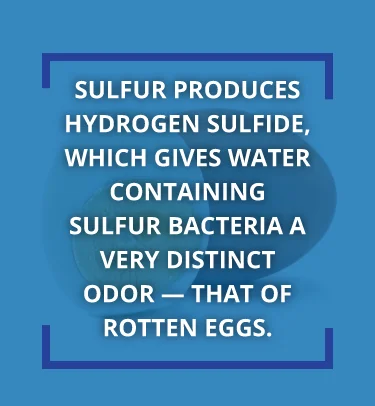 It does, however, produce hydrogen sulfide, which gives water-containing sulfur bacteria a very distinct odor — that of rotten eggs. In low quantities, hydrogen sulfide doesn't cause many problems. But, health issues can occur if the water contains high levels of gas.
It does, however, produce hydrogen sulfide, which gives water-containing sulfur bacteria a very distinct odor — that of rotten eggs. In low quantities, hydrogen sulfide doesn't cause many problems. But, health issues can occur if the water contains high levels of gas.
For example, prolonged exposure to hydrogen sulfide in amounts between two and five parts per million (ppm) can cause nausea, headaches, and insomnia. Prolonged exposure to higher concentrations of the gas can cause loss of smell, respiratory tract infection and conjunctivitis. Exposure to levels of 1000 ppm or more can result in death.
Sulfur Bacteria and Plumbing Issues
Sulfur bacteria can cause a few other problems for homeowners, beyond the risk for producing vast amounts of hydrogen sulfide. The bacteria do produce a slime that can clog plumbing systems. Additionally, the slime produced by sulfur bacteria can create a hospitable environment for iron bacteria. Hydrogen sulfide also causes a few problems beyond a rotten egg smell and potential health hazards. It can stain pipes and silverware black, as well as cause the corrosion of water pipes.
Sulfur bacteria can be found in a variety of locations within a plumbing system. For example, it might be in the water heater, so the distinct rotten eggs smell might only be noticeable when you run the hot water.
The bacteria can also be found in a water softener, in which case both hot and cold water would produce the smell, but only from the taps connected to the water softener. If your home doesn't have a water softener, or if you smell rotten eggs when running hot or cold water from a tap that isn't connected to the softener, it's likely that bacteria in your water distribution system or well are to blame.
When the bacteria aren’t located in the water itself, but instead are in a well or water softener, the sulfur scent usually diminishes after you've run the water for a few minutes. If the odor persists, it’s often a sign the water itself is harboring sulfur bacteria.
3. Legionella
Legionella is another type of bacteria naturally found in freshwater, such as lakes. It can also grow and thrive in artificial water systems, such as plumbing systems, water heaters, cooling towers — which are used to provide air conditioning to larger buildings — showers, and improperly drained hot tubs.
Legionella thrives in water between 68 and 120 degrees Fahrenheit. It also thrives when it has plenty to eat, usually in the form of a biofilm, a sticky substance made up of bacteria and moisture found on surfaces, including water and the interiors of water pipes.
Legionnaires' Disease
The big issue with legionella is that it causes a very dangerous form of pneumonia known as Legionnaires' disease. For the most part, you aren't exposed to the bacteria when you drink water contaminated with legionella.
Instead, the bacteria is spread by water droplets, which you can then inhale. If you take a drink from water contaminated with the bacteria and some of the water "goes down the wrong pipe," or into your trachea and into the lungs, you are also at risk for developing the disease.
Symptoms of Legionnaires' disease usually develop a few days after exposure but can take up to 10 days to appear. The symptoms usually include:
- Fever
- Headache
- Muscle aches
- Cough
- Chills
- Chest pain
- Shortness of breath
- Nausea and vomiting
Since the symptoms do seem like those of the flu, it’s possible to confuse the two at first. Legionella is also linked to another disease, Pontiac Fever, which causes flu-like symptoms but is milder than Legionnaires' disease.
Legionnaires' disease is a serious illness. Even with treatment, people can die from it. Without treatment, death is even more likely. About 10 percent of people diagnosed with Legionnaires' disease die from it. Treating the disease usually involves giving a person a course of antibiotics, which kills the bacteria. Most people need to be hospitalized if they are diagnosed with Legionnaires' disease, as well.

Ways You Can Keep Your Water Safe From Legionella and Other Bacteria
While iron bacteria and sulfur bacteria usually are little more than nuisances, learning your plumbing system has legionella bacteria can be downright scary. Along with having your water tested to confirm the presence of any potentially dangerous bacteria, there are a few steps you can take to try and eliminate the bacteria from your water supply. Here are four of them.
1. Turn Up Your Water Heater
To avoid scalding burns and to help conserve energy, it’s typically recommended that you keep the water heater in your home turned down to 120 degrees Fahrenheit. Unfortunately, 120 degrees Fahrenheit is within the preferred range for many bacteria, including legionella. Keeping your water heater that cools is the same as hanging up a sign that reads "Come on in, the water's fine!"
If you are worried about killing bacteria in your water system and keeping new bacteria from colonizing in your water, turn your water heater up to 140 degrees Fahrenheit. Keeping the heater turned up to that temperature to maintain an environment that's unwelcoming to bacteria.
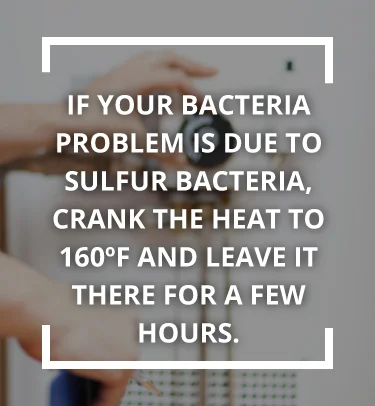 If your bacteria problem is due to sulfur bacteria, or if sulfur bacteria is one of many strains found in your plumbing system, you'll want to turn up the heat even more. Crank the heat to 160 degrees Fahrenheit and leave it there for a few hours. To avoid the risk of scalding, advise anyone in your home not to use the water during that time.
If your bacteria problem is due to sulfur bacteria, or if sulfur bacteria is one of many strains found in your plumbing system, you'll want to turn up the heat even more. Crank the heat to 160 degrees Fahrenheit and leave it there for a few hours. To avoid the risk of scalding, advise anyone in your home not to use the water during that time.
The high heat will kill off the sulfur bacteria. Once you've switched the temperature back to 140, flush out the water heater to remove any lingering traces of bacteria, as well as the rotten egg smell.
2. Install a Water Softener
Mineral deposits, or dissolved minerals in your water supply, can help enhance the flavor of your water. But, those minerals can also create an environment ideal for bacterial growth, particularly that of legionella.
To reduce the chance of having bacteria take over your water and make you or your family members ill, install a water softener. Soft water doesn't leave a scale or mineral build-up on the pipes, so there is less of a chance that a biofilm will develop.
3. Shock Your Water
If your water comes from a well, one way to reduce the levels of nuisance bacteria such as iron bacteria is to shock the water with chlorine. Shock chlorination usually involves introducing a very strong chlorine solution into the well — generally at least 1000 ppm. The chlorine solution is left to circulate through the well water and plumbing for about 24 hours, then is flushed out, taking the iron bacteria with it.
4. Filter Your Water
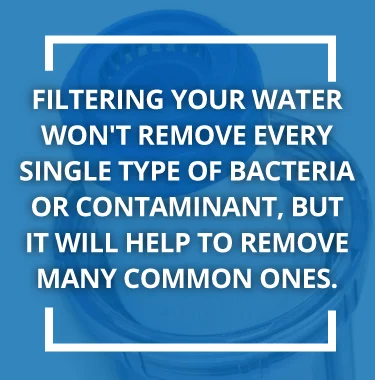 While filtering your water won't remove every single type of bacteria or contaminant, it will help to remove many common ones. The type of filter you choose is particularly important, as not all are effective against bacteria.
While filtering your water won't remove every single type of bacteria or contaminant, it will help to remove many common ones. The type of filter you choose is particularly important, as not all are effective against bacteria.
For example, the filters you find in water pitchers or sink attachments don't remove bacteria. Usually, a distillation unit is your best bet for water filtration if you are concerned about bacteria in your plumbing and water supply.
Call Mr. Rooter Plumbing for Plumbing Services in Oneida
Sometimes, critters, insects, and bacteria cause plumbing problems that are too big to take on solo. Whether you are dealing with an unwelcome visitor in your pipes or are concerned about the safety of your home's water, Mr. Rooter Plumbing of Oneida is here to help.
Our plumbing services include drain cleaning and repairing clogged drains, which can be particularly useful if you suspect a snake or possum has found its way into your drain pipe. We also install water softeners, which can improve the quality of your home's water and make your plumbing system a less attractive place for dangerous bacteria.
Mr. Rooter Plumbing employs a team of licensed plumbers, all of whom are experienced, insured, and ready to help you find the underlying cause — or causes — of your plumbing problems. We're dedicated to providing an exceptional customer service experience to every homeowner we work with.
To schedule an appointment at a time that works for you, call us or use our online service scheduler.


